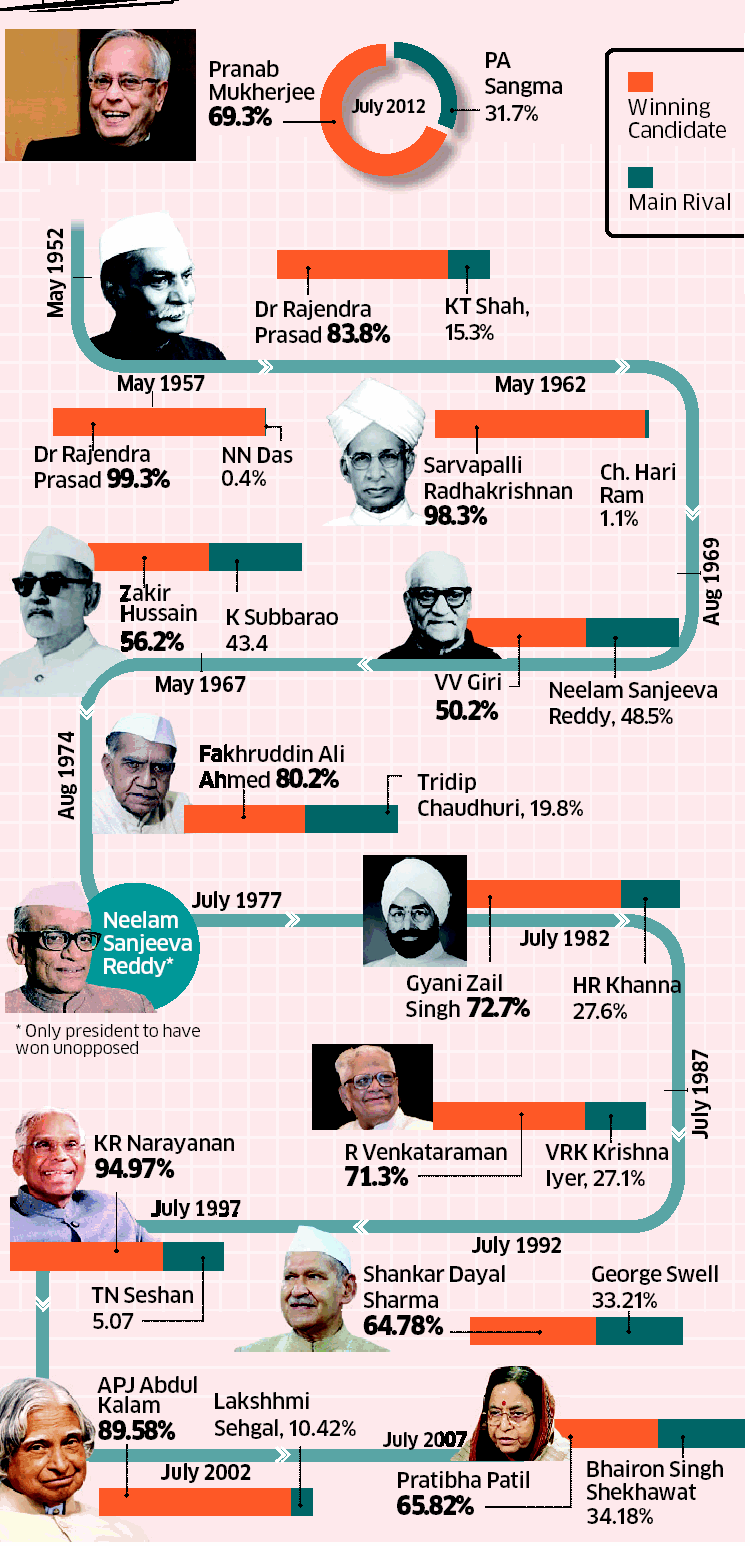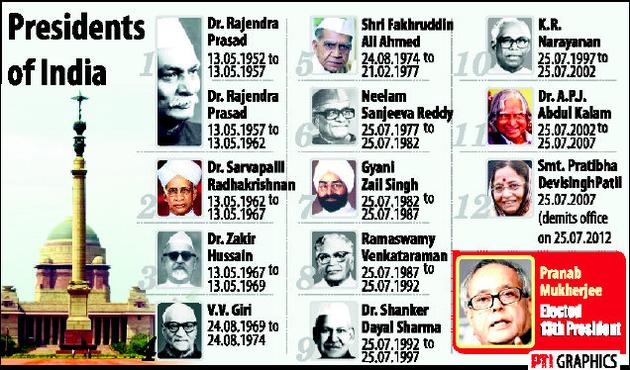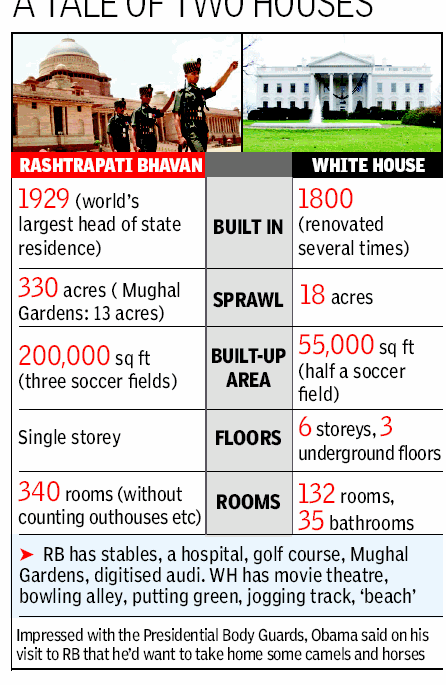How much does a President of India earn? One of the major perks of being a President is living in Rashtrapati Bhavan. It takes over Rs 30 crore annually to keep the Rashtrapati and his Bhavan in top shape. In this article we have outlined how President is selected, the Salary and Perks of President, how rich was Pratibha Patil and about Rashtrapati Bhavan, and how much bill we foot. How can one visit the Rashtrapati Bhavan?
I pay 2.75 lakh tax on 5 lakh salary: President Kovind
“The President is the highest paid employee of the country, and he also pays taxes. But someone will say that you get five lakh rupees… everyone talks about that. Out of that, every month, a quarter to three lakh comes out. So, how much is left? Our officers and others get more than what is left. The teachers who are sitting (at the event), they all get more.” President Ram Nath Kovind
Table of Contents
Salary of President of India
One of the highlights of the Union Budget 2018 was the decision of the government to increase the salary of the President, Vice-President and the Governor. The matter needs Parliament’s approval which is expected in the current Budget session. Once cleared, the salary will be made applicable from February 2016.
This is to correct the anomaly. After the implementation of the 7th Pay Commission’s awards on 1 January 2016, the cabinet secretary, who is the top-most bureaucrat in the country, gets Rs 2.5 lakh per month and a secretary in the Union government draws Rs2.25 lakh per month. The President is also the supreme commander of all the three armed forces — the Army, Air Force, and Navy. However, the President’s current salary was less than the chiefs of the three armed forces, who draw a salary equivalent to the cabinet secretary.
- The salary of the President has been increased from the current 1.5 lakh a month to 5 lakh a month.
- The Vice-President’s salary will increase to Rs 4 lakh a month from the existing Rs 1.10 lakh a month.
The scale of increase has also impacted the salary of the Governor who would now earn a salary of Rs 3.5 lakh per month.
Salaries of the president, vice-president, and governors were last hiked in 2008 when the Parliament had approved a three-fold increase. Till 2008, the President’s salary was Rs 50,000, the Vice-President’s Rs40,000 and a Governor’s Rs36,000 per month.
In 2009, the then President Pratibha Patil had approved the law giving her a 300 percent hike in salary taking her monthly pay cheque to Rs 1.5 lakh from Rs 50,000 per month in the New Year.
She had also given her assent to another law that hiked the monthly salary of the then Vice-President M H Ansari’s salary from Rs 40,000 to Rs 1.25 lakh per month.
You can read Pay and perks of Indian MP, MLA and Prime Minister for salary of Indian MP
Salary and Perks of President of India
The official website of the President of India is http://presidentofindia.nic.in/
- A president draws a salary of Rs.5 lakh a month.
- The President lives in Rashtrapati Bhavan–the largest presidential palace in the world. The palace covers 5 acres, has an area of 19,000 square metres and is part of a 330-acre estate in the heart of the national capital.
- He has a secretarial staff of five people and another 200 people employed for the upkeep of Rashtrapati Bhavan.
- The President has two equally lavish holiday retreats. One is the Rashtrapati Nilayam in Hyderabad and the other is the Retreat Building in Shimla.
- The President travels with a cavalcade of 25 cars. The vehicle of choice for President Pranab Mukherjee was an extended and armoured Mercedes-Benz S600. Apart from that, he is accompanied by the President’s presidential bodyguard. It includes 86 presidential guards mounted on magnificent horses.
- The President and the spouse can travel to anyplace in the world free of cost.
- The President is allotted a maintenance budget of up to Rs 30 crore for the upkeep of his palace.
- He is also allotted a personal budget by the government to handle all the expenses of the President done in his official capacity, which includes mostly every piece of business, visits, hosting events, guests, state leaders etc. The daily expenses of the President are also covered in this budget.
As a part of steps to make more resources available for Covid-19 relief measures, the President of India, Shri Ram Nath Kovind, after contributing one month’s salary to the PM-CARES Fund in March, has decided to forego 30 percent of his salary for a year.
You can read US President: Salary, Benefits, Expenses and Retirement Benefits for details on US President Salary, Benefits and Expenses.
President Perks After Retirement
As per current rules, the President receives a monthly pension of Rs 75,000 after retiring.
- The President is given a Type-VIII rent free furnished bungalow to stay. This is the biggest and best accommodation provided by the Government of India to anyone apart from the incumbent president and prime minister.
- The President is also given two landlines and a mobile phone–all bills paid by the government.
- Five personal staff, including a private secretary, are allotted to him.
- The perks include a free official car along with Rs 60,000 as staff expense. The President is also given 250 litres of free petrol a month. If they choose to use their personal vehicle for commute instead of the official car, the government also gives the salary of the driver to the President.
You can read Salaries of leaders of the world : Modi,Barack Obama,Angela Merkel,Vladmin Putin,Bill Clinton for details on salary of World leaders.
Is the President’s salary taxable? How much tax Does President Pay?
If yes, how much tax should he be paying? Does he receive any tax benefits, considering the significance of the office he holds?
Neither the Income Tax Act nor the President (Emoluments And) Pension Act specifically exempt the salary of the President of India from taxation. Therefore, it appears that President does pay tax on his income. But there is not much clarity on what is the nature of the President’s income – is it given as a “salary” or in the form of “income from other sources.”
“The tax computation for the current financial year for an income of Rs 5 lakh per month comes to about Rs 17.60 lakh annually, translating to Rs 1.47 lakh tax deduction every month, approximately. This calculation assumes that the President has opted for a concessional tax rate regime. But it doesn’t consider any deductions on account of eligible investments & tax concessions, as the same is not in the public domain. However, if the President hasn’t opted for the concessional tax rate regime, the tax liability increases to Rs 18.42 lakh, translating to a monthly tax bill of Rs 1.53 lakh approximately.”
So, where does the figure of “Rs 2.75 lakh” come from? The President might be including the 30 percent pay-cut* due to COVID in this “tax claim.”
“Considering that the monthly tax liability doesn’t add up to Rs 3 lakh, as stated, it may be possible that the President had considered the 30 percent pay-cut to arrive at the figure of Rs 3 lakh. A 30 percent pay cut on a Rs 5 lakh income means that the President is already getting Rs1.5 lakh less, in hand. The tax liability calculated earlier along with this pay cut tallies the figures provided by the President. This probably was what he intended to convey.”
Rashtrapati Bhavan where President of India Lives
How to Visit Rashtrapati Bhavan
- The Rashtrapati Bhavan, home to the President of India, has been thrown open to the public for four days in a week: Thursday, Friday, Saturday and Sunday from 9 am to 4 pm.
- Visitors will need to make an online booking before their visit at rashtrapatisachivalaya.gov.in/rbtour.
- Charges for visiting the presidential house are Rs 50 per person. Children below the age of eight years of age will be allowed free of cost.
- visitors will be able to see the main building, which shall include the Forecourt and premier rooms of the Bhavan, including the Banquet Hall, Ashok Hall, Durbar Hall, Library, North Drawing Room, Long Drawing Room, Navachara and more.
- The YouTube Video given below explains the process in detail.
- You can also take a virtual tour of Rashtrapati Bhawan at http://presidentofindia.nic.in/virtual-tour-of-rashtrapati-bhavan.htm
From official website Presidentofindia.nic.in:Panaromic View
Durbar Hall – 2-ton chandelier hanging from a height of 33 meters. Known during the British rule as Throne Room.Used for State functions: Defence Investiture ceremony, conferring of Padma Awards, etc
Ashoka Hall-The Ashoka Hall,which gives the feel of a large jewel box, is a rectangle measuring 32 metres by 20 metres.It was originally built as the State Ballroom: it has a wooden floor,a central dance space, and three vestibules. Unlike most halls and chambers in Rashtrapati Bhawan, the Ashoka Hall has a painted ceiling. The painting is in the Persian style. The main painting on the roof depicts a royal hunting expedition while those towards the corners show scenes from court life.
Banquet Hall: State Dining Hall, now known as Banquet Hall. Can seat 104 persons. Portraits of all former Presidents embellish its walls. An assortment of medieval arms on display.
North Drawing Room: Is for receiving visiting Heads of State.Two paintings are conspicuous: Transfer of power on August 14 by Shri S.N.Goshal and Swearing-in ceremony of First Indian Governor-General by Shri Thakur Singh.
The Mughal Gardens situated at the back of the Rashtrapati Bhavan incorporates both Mughal and English landscaping styles and feature a vast variety of flowers. The Rashtrapati Bhavan gardens are open to the public in February every year.
Take a 20 min video tour of Rashtrapati bhawan from NDTV video
President Polls
Ram Nath Kovind is the President of India since 25 July 2017. The incumbent is eligible for re-election, as no term limits exist in India.
The President is indirectly elected by an electoral college comprising the Parliament of India (both houses) and the Legislative Assemblies of each of India’s states and territories, who themselves are all directly elected.
Although the Article 53 of the Constitution of India states that the President can exercise his powers directly or by subordinate authority, with few exceptions, all of the executive powers vested in the President are, in practice, exercised by the Prime Minister (a subordinate authority) with the help of the Council of Ministers.[2] The President is bound by the constitution to act on the advice of the Prime Minister and Cabinet as long as the advice is not violating the constitution.
President is chosen by an electoral college consisting of the elected members of both houses of Parliament, the elected members of the State Legislative Assemblies (Vidhan Sabha) and the elected members of the legislative assemblies of the Union Territories of Delhi and Puducherry. The election is held in accordance to the system of Proportional representation by means of Single transferable vote method. The Voting takes place by a secret ballot system.
The manner of election of President is provided by Article 55 of the Constitution. Rediff:Election to the office of President of India 2012 (pdf) explains the process by Election Commission of India.
AnupamPatra:On How The President of India Is Elected explains it in conversation style.
As of 2017, the electoral college comprises 776 MPs and 4120 MLAs. The total strength of Electoral College is 10,98,882 votes. Halfway mark is 5,49,442 votes. After state assembly elections and by-polls of 2017, NDA is short of nearly 20,000 votes.
The nomination of a candidate for election to the office of the President must be subscribed by at least 50 electors as proposers and 50 electors as seconders. The election is held in accordance with the system of proportional representation by means of the Single transferable vote method. The voting takes place by secret ballot.
Presidents of India with their tenure is given in image below.
How rich was our 12th President Smt. Pratibha Patil?
Smt Pratibha Patil holds assets,Immovable Assets and Movable Assets, worth Rs 2.49 Crores with 30-40% in real estate, 40-50% in debt, 10-15% in gold and almost zero equity. TFLGuide:Let’s Advice President Pratibha Patil on her Investments is an interesting read.
Comparing Rashtrapati Bhavan to White House
Bills we foot of our President: Electricity Bill, Travel Bill
Quoting from Deccanherald:Power bill of Prez, PM and Parliament put at Rs 14 cr(2008) The hallowed portals of power — Rashtrapati Bhavan, Parliament and the Prime Minister’s official residence—have together spent about Rs 14 crore on electricity , an RTI reply has revealed. The figures reported were as follows
| 2008 | 2007 | 2006 | 2005 | |
| Parliament | 6.25 crore | |||
| Rashtrapati Bhavan | 6.70 crore | 4.34 crore | 4 crore | 3.20 cr |
| Prime Minister’s residence | 50.35 lakh | 12.39 lakh | 15.16 lakh | 7.48 lakh |
Travel Bills of Smt Pratibha Patil: Quoting from DNA:President Pratibha Patil’s trips cost record Rs205 crore (Mar 2012)
Since assuming office as the country’s first woman President in July 2007, Patil has undertaken 12 foreign trips covering 22 countries across four continents. A series of RTI applications has revealed that Air India incurred over Rs169 crore on use of chartered aircraft, always a Boeing 747-400, on the foreign visits by Patil, mostly accompanied by her family members. A visit to Bhutan was covered by a smaller jet. Patil has so far visited Brazil, Mexico, Chile, Bhutan, Vietnam, Indonesia, Spain, Poland, Russia, Tajikistan, the UK, Cyprus, China, Laos, Cambodia, the UAE, Syria, Mauritius, South Korea, Switzerland and Austria spending a total of 79 days abroad.
Her immediate predecessor Dr APJ Abdul Kalam undertook seven trips to 17 countries during his five-year tenure. Before that, KR Narayanan covered 10 countries in six trips and SD Sharma 16 countries in four trips.
Powers of President of India
If wondering why do we have a President. The President of India is the constitutional head of the State and the government. He is the first citizen of India. The administration of the whole country is carried on in his name. The constitution has given him a large number of powers. But being the nominal head of the State, he does not use his powers. In reality, his powers are exercised by Council of Ministers. His powers can be classified into Executive, Financial, Legislative, Judicial, Emergency categories: Quoting from Brief Notes on the five Important Powers of President of India on Executive and Financial powers.
I. Executive Powers of President: . The President is the chief executive of the country. Administration of the country is carried out on his name. 2. He is the Supreme Commander of the Indian Armed Forces. 3. He appoints the Prime Minister and the other members of the Council of Ministers at the centre. 4. He makes major appointments in the country, such as Governors of the States, the Judges of the Supreme Court and High Courts, Election Commissioner, Auditor General of India. 5. He makes the appointments of Indian Ambassadors to other countries and receives the ambassadors of other countries to India.
II. Financial Powers of President: 1. No Money Bill can be presented before the Lok Sabha without the prior permission of the President. 2. Budget of the Centre Government is presented before the Lok Sabha by the Union Finance Minister only with the permission of the President. 3. He distributes the Income Tax and the Jute Export Tax between the Centre and the States.
Take a video tour of Rashtrapati Bhawan from NDTV video
Related Articles:
- US President: Salary, Benefits, Expenses and Retirement Benefits
- President Obama and Money
- Obamas Financial Struggle
- Pay and perks of Indian MP, MLA and Prime Minister
- Cost of India Lok Sabha Elections 2014
- President of India and Rashtrapati Bhavan
- Salaries of leaders of the world : Modi,Barack Obama,Angela Merkel,Vladmin Putin,Bill Clinton








rashtrapati bavan is better
I pay a quick visit each day a few web sites and blogs to read articles, however this web
site offers feature based writing.